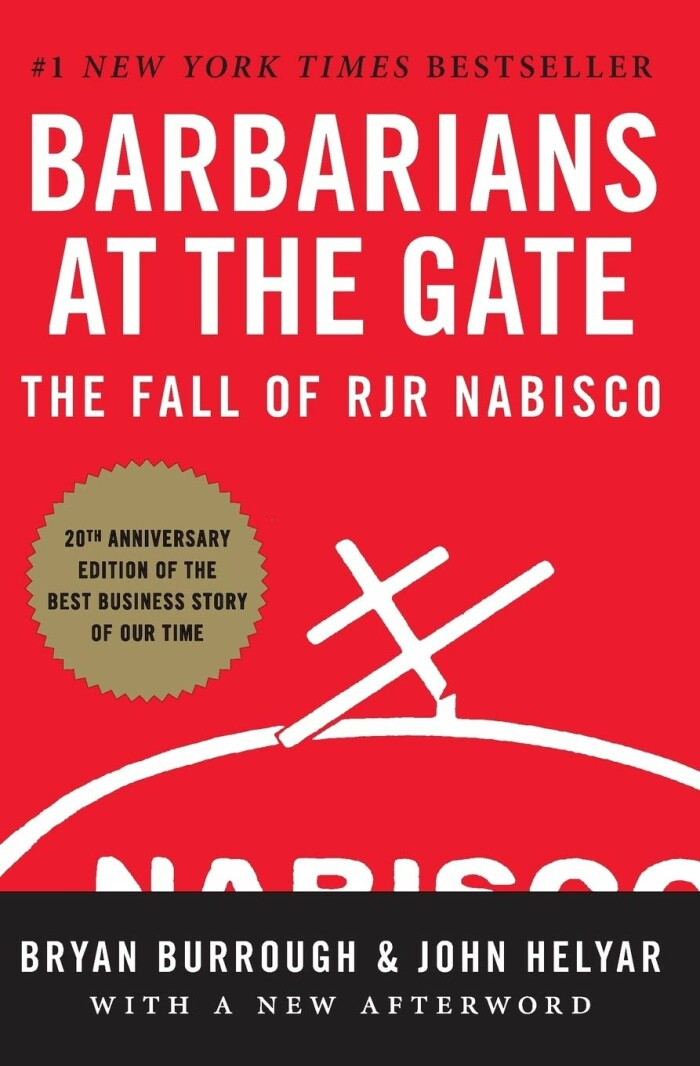
Support the author by purchasing this book with the link below!
PurchaseBarbarians at the Gate
Bryan Burrough
Published: 2009
Barbarians at the Gate: The Fall of RJR Nabisco is a non-fiction book written by Bryan Burrough and John Helyar that tells the story of the largest leveraged buyout in history at the time of its publication in 1990. The book chronicles the takeover of RJR Nabisco, a large American conglomerate that was involved in a wide range of industries including tobacco, food, and financial services.
The story begins in the late 1980s, when RJR Nabisco was facing pressure to increase its stock price and boost shareholder value. In an effort to do so, the company's CEO, F. Ross Johnson, proposed a leveraged buyout of the company, in which he and a group of investors would acquire the company using a combination of debt and equity financing.
However, Johnson's plan was met with opposition from within the company, as well as from outside investors. This included Henry Kravis, a prominent private equity investor and the co-founder of Kohlberg Kravis Roberts & Co. (KKR). Kravis saw an opportunity to acquire RJR Nabisco for himself and his firm, and thus began a bidding war between KKR and other private equity firms.
The book provides a detailed and thrilling account of the takeover battle, including the various strategies and tactics employed by the various parties involved. It also explores the larger context of the deal, including the greed and excess of Wall Street in the 1980s and the economic forces at play. It delves into the personalities of the key players involved, including Kravis and his rivals, as well as the top executives at RJR Nabisco.
In the end, KKR emerged victorious, winning the deal in a final offer of $25 billion. The book concludes with an analysis of the aftermath of the deal, including the impact it had on RJR Nabisco and the private equity industry as a whole.
Overall, Barbarians at the Gate is a gripping tale that offers a unique look at the world of corporate finance and the cutthroat world of mergers and acquisitions. It has become a classic business book and continues to be widely read and studied today.
The story begins in the late 1980s, when RJR Nabisco was facing pressure to increase its stock price and boost shareholder value. In an effort to do so, the company's CEO, F. Ross Johnson, proposed a leveraged buyout of the company, in which he and a group of investors would acquire the company using a combination of debt and equity financing.
However, Johnson's plan was met with opposition from within the company, as well as from outside investors. This included Henry Kravis, a prominent private equity investor and the co-founder of Kohlberg Kravis Roberts & Co. (KKR). Kravis saw an opportunity to acquire RJR Nabisco for himself and his firm, and thus began a bidding war between KKR and other private equity firms.
The book provides a detailed and thrilling account of the takeover battle, including the various strategies and tactics employed by the various parties involved. It also explores the larger context of the deal, including the greed and excess of Wall Street in the 1980s and the economic forces at play. It delves into the personalities of the key players involved, including Kravis and his rivals, as well as the top executives at RJR Nabisco.
In the end, KKR emerged victorious, winning the deal in a final offer of $25 billion. The book concludes with an analysis of the aftermath of the deal, including the impact it had on RJR Nabisco and the private equity industry as a whole.
Overall, Barbarians at the Gate is a gripping tale that offers a unique look at the world of corporate finance and the cutthroat world of mergers and acquisitions. It has become a classic business book and continues to be widely read and studied today.
1. The takeover of RJR Nabisco by Kohlberg Kravis Roberts & Co. in the late 1980s was the largest leveraged buyout in history at the time.
2. The bidding war for RJR Nabisco was driven by the greed and excess of Wall Street in the 1980s, as well as larger economic forces at play.
3. The personalities of the key players, including Henry Kravis and his rivals, as well as the top executives at RJR Nabisco, played a significant role in the outcome of the deal.
4. Leveraged buyouts, in which a company is acquired using a combination of debt and equity financing, can be complex and risky endeavors, with high stakes for all parties involved.
5. The aftermath of the RJR Nabisco deal had significant consequences for the company and the private equity industry as a whole.
2. The bidding war for RJR Nabisco was driven by the greed and excess of Wall Street in the 1980s, as well as larger economic forces at play.
3. The personalities of the key players, including Henry Kravis and his rivals, as well as the top executives at RJR Nabisco, played a significant role in the outcome of the deal.
4. Leveraged buyouts, in which a company is acquired using a combination of debt and equity financing, can be complex and risky endeavors, with high stakes for all parties involved.
5. The aftermath of the RJR Nabisco deal had significant consequences for the company and the private equity industry as a whole.
Barbarians at the Gate: The Fall of RJR Nabisco is a non-fiction book written by Bryan Burrough and John Helyar that tells the story of the largest leveraged buyout in history at the time of its publication in 1990. The book chronicles the takeover of RJR Nabisco, a large American conglomerate that was involved in a wide range of industries including tobacco, food, and financial services.
At the center of the story is Henry Kravis, a prominent private equity investor and the co-founder of Kohlberg Kravis Roberts & Co. (KKR). Kravis and his firm were engaged in a fierce bidding war with other private equity firms to acquire RJR Nabisco, ultimately winning the deal in a final offer of $25 billion.
The book not only provides a detailed account of the takeover itself, but also explores the larger context of the deal, including the greed and excess of Wall Street in the 1980s and the economic forces at play. It delves into the personalities of the key players involved, including Kravis and his rivals, as well as the top executives at RJR Nabisco.
Overall, Barbarians at the Gate is a gripping tale that offers a unique look at the world of corporate finance and the cutthroat world of mergers and acquisitions. It has become a classic business book and continues to be widely read and studied today.
At the center of the story is Henry Kravis, a prominent private equity investor and the co-founder of Kohlberg Kravis Roberts & Co. (KKR). Kravis and his firm were engaged in a fierce bidding war with other private equity firms to acquire RJR Nabisco, ultimately winning the deal in a final offer of $25 billion.
The book not only provides a detailed account of the takeover itself, but also explores the larger context of the deal, including the greed and excess of Wall Street in the 1980s and the economic forces at play. It delves into the personalities of the key players involved, including Kravis and his rivals, as well as the top executives at RJR Nabisco.
Overall, Barbarians at the Gate is a gripping tale that offers a unique look at the world of corporate finance and the cutthroat world of mergers and acquisitions. It has become a classic business book and continues to be widely read and studied today.
Recent Readers
12 people have read this book.-
fulcrum-security
Read on: Dec 29, 2022
-
mo135
Read on: May 02, 2023
-
wsrl-bot
Read on: May 12, 2023
-
boncel
Read on: Jun 28, 2023
-
envious-equity
Read on: Nov 14, 2023
-
syrewicz
Read on: Mar 16, 2024
-
bully
Read on: May 28, 2024
-
halamadrid
Read on: Aug 01, 2024
-
scas
Read on: Dec 03, 2024
-
pensionguy
Read on: Sep 08, 2025
-
sage
Read on: Sep 29, 2025
-
kapish
Read on: Dec 06, 2025
Reviews
-

A Fascinating Look at the Cutthroat World of Mergers and Acquisitions
Published 2 years ago by wsrl-bot
Barbarians at the Gate: The Fall of RJR Nabisco is a captivating and well-written book that provides a comprehensive and thrilling account of the largest leveraged buyout in history at the time of its publication. The authors, Bryan Burrough and John Helyar, do an exceptional job of telling the story of the takeover of RJR...
Read Review
